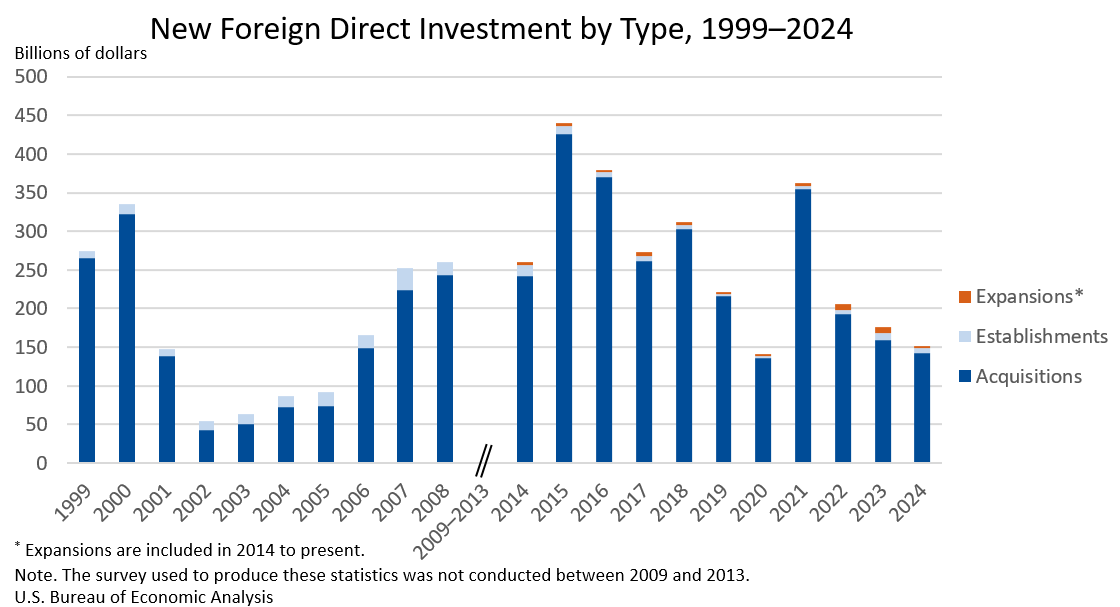Bureau of Economic Analysis
New Foreign Direct Investment in the United States, 2024
Expenditures by foreign direct investors to acquire, establish, or expand U.S. businesses totaled $151.0 billion in 2024, according to preliminary statistics released today by the U.S. Bureau of Economic Analysis. Expenditures decreased $24.9 billion, or 14.2 percent, from $176.0 billion (revised) in 2023 and were below the annual average of $277.2 billion for 2014–2023. As in previous years, acquisitions of existing U.S. businesses accounted for most of the expenditures.
Principal Federal Economic Indicators
Noteworthy
- 2025 News Release Schedule
- Innovation at BEA
- 2025 Annual Updates
- New! Services Trade Data for More Countries
- Data Tool: Trade in Value Added
- Distribution of State Personal Income
- Updated: RIMS II Regional Multipliers
- Arts and Culture
- Space Economy
- FDI Now in State BEARFACTS
- Quick Guide: Price Indexes
The Latest
New Foreign Direct Investment in the United States, 2014 and 2015
Expenditures by foreign direct investors to acquire, establish, or expand U.S. businesses totaled $420.7 billion in 2015, an increase of 68 percent from 2014, when expenditures were $250.6 billion; according to the Bureau of Economic Analysis (BEA) in statistics released today.
Some additional highlights of the statistics on new foreign direct investment for 2015:
New Foreign Direct Investment in the United States, 2014 and 2015
Expenditures by foreign direct investors to acquire, establish, or expand U.S. businesses totaled $420.7 billion in 2015, an increase of 68 percent from 2014, when expenditures were $250.6 billion. In 2015, as in 2014, the majority of the expenditures were to acquire existing businesses. In 2015, expenditures for acquisitions were $408.1 billion. Expenditures to establish new U.S. businesses were $11.2 billion, and expenditures to expand…
Real Personal Income for States, 2014
Real personal income across all regions rose by an average of 2.9 percent in 2014. This growth rate reflects the year-over-year change in nominal personal income across all regions adjusted by the change in the national personal consumption expenditures (PCE) price index. On a nominal basis, personal income across all regions grew an average of 4.4 percent in 2014. In 2014, the U.S. PCE price index grew 1.4 percent.
Real Personal Income for States and Metropolitan Areas
Real personal income across all regions rose by an average of 2.9 percent in 2014. This growth rate reflects the year-over-year change in nominal personal income across all regions adjusted by the change in the national personal consumption expenditures (PCE) price index. On a nominal basis, personal income across all regions grew an average of 4.4 percent in 2014. In 2014, the U.S. PCE price index grew 1.4 percent.
May 2016 Trade Gap is $41.1 Billion
The U.S. monthly international trade deficit increased in May 2016 according to the U.S. Bureau of Economic Analysis and the U.S. Census Bureau. The deficit increased from $37.4 billion in April (revised) to $41.1 billion in May, as exports decreased and imports increased. The previously published April deficit was $37.4 billion. The goods deficit increased $3.7 billion from April to $62.2 billion in May. The services surplus decreased $0.1…
U.S. International Trade in Goods and Services, May 2016
U.S. Census Bureau U.S. Bureau of Economic Analysis NEWS U.S. Department of Commerce * Washington, DC 20230 U.S. INTERNATIONAL TRADE IN GOODS AND SERVICES May 2016 The U.S. Census Bureau and the U.S.
Coming July 13: Statistics on New Foreign Investment in 2014 and 2015
SUITLAND, Md. — Statistics detailing the amount and type of new direct investments made in the United States by foreign investors will be released by the Bureau of Economic Analysis on Wednesday, July 13.
The data will be available in a news release on BEA’s website at 8:30 a.m. eastern time. The statistics cover new direct investments initiated in 2015 and 2014 and will provide information on:
U.S. Net International Investment Position: End of the First Quarter of 2016
The U.S. net international investment position at the end of the first quarter of 2016 was -$7,525.6 billion (preliminary) as the value of U.S. liabilities exceeded the value of U.S. assets. At the end of the fourth quarter of 2015, the net investment position was -$7,280.6 billion (revised).
U.S. International Investment Position, 1st quarter 2016, annual 2015, and annual revisions
First Quarter of 2016
The U.S. net international investment position at the end of the first quarter of 2016 was −$7,525.6 billion (preliminary) as the value of U.S. liabilities exceeded the value of U.S. assets (chart 1, table 1). At the end of the fourth quarter of 2015, the net investment position was -$7,280.6 billion (revised).
Why Do Old GDP Numbers Keep Changing?
BEA is getting ready for its big summer update of GDP and other national economic statistics, coming in late July. This annual ritual of refining figures from the last three years can be confusing. People wonder: Were the old numbers wrong? Are these new figures final? No, and not really.




